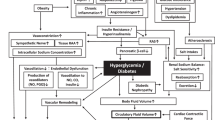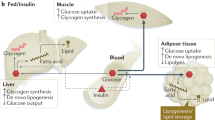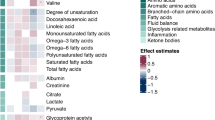Abstract
Reduced insulin-mediated glucose disposal, indicative of insulin resistance, has been demonstrated in lean male hypertensives both with the hyperinsulinaemic euglycaemic clamp and the insulin suppression test. In lean hypertensives, insulin resistance was not accompanied by increases in fasting plasma insulin and glucose levels; but with modest hyperglycaemia and hyperinsulinaemia after a glucose load. Population studies (no stratification) reveal that: (1) insulin sensitivities vary widely in normotensives and hypertensives, (2) there are hypertensives and normotensives with similar degrees of insulin resistance, (3) not all hypertensives are insulin resistant, and (4) insulin resistance does not contribute to the blood pressure level of the hypertensive population. In large cross-sectional studies, the clustering of obesity, dyslipidaemia and type 2 diabetes is largely responsible for the observed associations between insulin or insulin resistance and hypertension. Recent studies indicate a role of glucose in blood pressure control. Glucose has been shown to elevate blood pressure in the presence of endothelial dysfunction and glucose values in the upper-normal range have been shown to be associated with increased cardiovascular mortality. Since endothelial dysfunction is present in hypertensives, dyslipidaemic, obese and in glucose intolerant individuals, lowering of high-normal glucose levels becomes a new, additional therapeutic target in the management of these patients. Hyperglycaemia together with endothelial dysfunction may account for the increased incidence of hypertension in obesity and diabetes mellitus. Because of the strong association between insulin resistance, hyperglycaemia and endothelial dysfunction, and the clustering of risk factors in these subjects, we propose the lowering of high normal glucose levels as part of the therapeutic strategy to prevent cardiovascular and metabolic disease.
This is a preview of subscription content, access via your institution
Access options
Subscribe to this journal
Receive 12 digital issues and online access to articles
$119.00 per year
only $9.92 per issue
Buy this article
- Purchase on SpringerLink
- Instant access to full article PDF
Prices may be subject to local taxes which are calculated during checkout
Similar content being viewed by others
References
Ferrannini E . Insulin resistance in essential hypertension N Engl J Med 1987 317: 350–357
Capaldo B et al. Skeletal muscle is a primary site of insulin resistance in essential hypertension Metabolism 1991 40: 1320–1322
Reaven GM . Relationships between insulin resistance and hypertension Diabetes Care 1991 14: 33–38
Laakso M, Sarlund H, Mykkanen L . Essential hypertension and insulin resistance in non-insulin-dependent diabetes Eur J Clin Invest 1989 19: 518–526
Modan M et al. Hyperinsulinaemia: a link between hypertension, obesity and glucose intolerance J Clin Invest 1985 75: 809–817
DeFronzo RA . Insulin resistance, hyperinsulinemia, and coronary artery disease: a complex metabolic web J Cardiovasc Pharmacol 1992 20 (Suppl 11): S1–S16
Maheux P et al. Additive effects of obesity, hypertension and type-2 diabetes on insulin resistance Hypertension 1994 24: 695–698
Reaven GM . Role of insulin resistance in human disease Diabetes 1988 37: 1595–1607
Swislocki AL, Hoffman BB, Reaven GM . Insulin resistance, glucose intolerance and hyperinsulinemia inpatients with essential hypertension Am J Hypertens 1989 2: 419–423
Fuenmayor N, Moreira E, Cubeddu LX . Salt sensitivity is associated with insulin resistance in essential hypertension Am J Hypertens 1998 11: 397–402
Welborn TA et al. Serum insulin in essential hypertension and in peripheral vascular disease Lancet 1966 1: 1336–1337
Denker PS, Pollock VE . Fasting insulin levels in essential hypertension: a meta-analysis Arch Int Med 1992 152: 1649–1651
Toft I, Bonaa KH, Jenssen T . Insulin resistance in hypertension is associated with body fat rather than blood pressure Hypertension 1998 32: 115–122
Muller DC et al. An epidemiological test of the hyperinsulinemia-hypertension hypothesis J Clin Endocrinol Metab 1993 3: 544–548
Cubeddu LX et al. Insulin and blood pressure responses to changes in salt intake J Hum Hypertens 2000 14: S32–S35
Singer P et al. Postprandial hyperglycemia inpatients with mild essential hypertension Hypertension 1985 7: 182–186
Lind L, Berne C, Lithell H . Prevalence of insulin resistance in hypertension J Hypertens 2000 35: 451–456
Saad MF et al. Racial differences in the relation between blood pressure and insulin resistance N Engl J Med 1991 324: 733–739
Bjornholt JV et al. Fasting blood glucose: an underestimated risk factor for cardiovascular death. Results from a 22-year follow-up of healthy nondiabetic men Diabetes Care 1999 22: 45–49
Reaven GM, Ho H . Sugar-induced hypertension in Sprague-Dawley rats Am J Hypertens 1991 4: 610–614
Brands MW, Fitzgerald SM . Chronic glucose infusion causes moderate hypertension in rats Am J Hypertens 2000 13: 99–102
Claxton CR, Brands MW, Fitzgerald SM, Cameron JA . Inhibition of nitric oxide synthesis potentiates hypertension during chronic glucose infusion in rats Hypertension 2000 35: 451–456
Steinberg HO et al. Obesity/insulin resistance is associated with endothelial dysfunction J Clin Invest 1996 97: 2601–2610
Pinkney JH, CDA Stehouwer, Coppack SW, Yudkin JS . Endothelial dysfunction: cause of the insulin resistance syndrome Diabetes 1997 46: S9–S13
Higashi Y et al. Relationship between insulin resistance and endothelium-dependent vascular relaxation inpatients with essential hypertension Hypertension 1997 29: 280–285
Scherrer U, Randin D, Vollenweider L, Nicod P . Nitric oxide release accounts for insulin's vascular effects in humans J Clin Invest 1994 94: 2511–2515
Vollenweider P et al. Impaired insulin-induced sympathetic neural activation and vasodilation in skeletal muscle of obese humans J Clin Invest 1994 93: 2365–2371
Gudbjornsdottir S, Elam M, Sellgren J, Anderson EA . Insulin increases forearm vascular resistance in obese, insulin-resistant hypertensives J Hypertens 1996 14: 91–97
Author information
Authors and Affiliations
Corresponding author
Additional information
The study was supported by Grants from CONICT S1-96001890 and CDCH.F06.10.4214. 98
Rights and permissions
About this article
Cite this article
Cubeddu, L., Hoffmann, I. Insulin resistance and upper-normal glucose levels in hypertension: a review. J Hum Hypertens 16 (Suppl 1), S52–S55 (2002). https://doi.org/10.1038/sj.jhh.1001343
Published:
Issue date:
DOI: https://doi.org/10.1038/sj.jhh.1001343
Keywords
This article is cited by
-
Alcohol consumption, homeostasis model assessment indices and blood pressure in middle-aged healthy men
Journal of Human Hypertension (2004)
-
Low fasting serum insulin in Japanese alcohol consumers does not imply improved coronary risk factors
Environmental Health and Preventive Medicine (2004)



